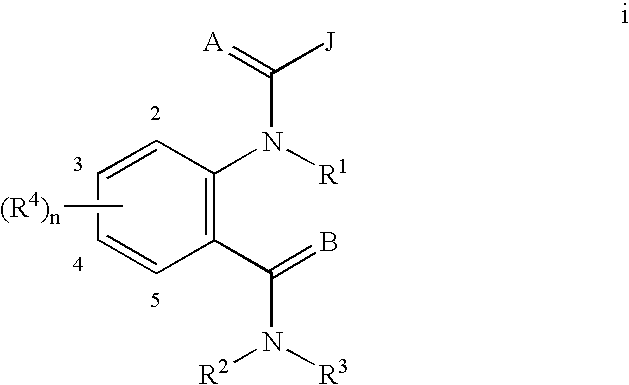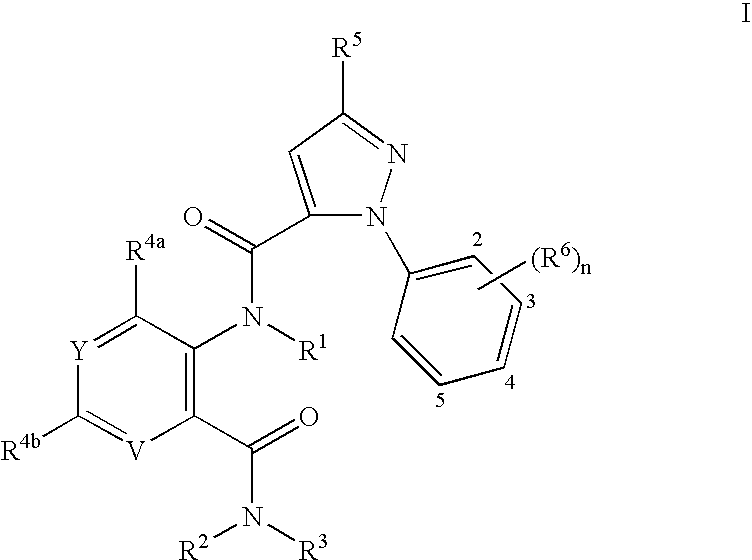Novel anthranilamide insecticides
an anthranilamide and insecticide technology, applied in the field of heterocyclic amides, can solve the problems of increased cost to consumers and significant productivity reduction
- Summary
- Abstract
- Description
- Claims
- Application Information
AI Technical Summary
Problems solved by technology
Method used
Image
Examples
example 1
Preparation of 1-(3-Chloro-2-pyridinyl)-N-[2,4-dichloro-6-[(methylamino)carbonyl]phenyl]-3-[(methylsulfonyl)oxy]-1H-pyrazole-5-carboxamide
Step A: Preparation of Ethyl 1-(3-chloro-2-pyridinyl)-3-pyrazolidinone-5-carboxylate
[0109] A 2-L four-necked flask equipped with a mechanical stirrer, thermometer, addition funnel, reflux condenser, and nitrogen inlet was charged with absolute ethanol (250 mL) and an ethanolic solution of sodium ethoxide (21%, 190 mL, 0.504 mol). The mixture was heated to reflux at about 83° C. It was then treated with 3-chloro-2-hydrazinopyridine (68.0 g, 0.474 mol). The mixture was re-heated to reflux over a period of 5 minutes. The yellow slurry was then treated dropwise with diethyl maleate (88.0 mL, 0.544 mol) over a period of 5 minutes. The reflux rate increased markedly during the addition. By the end of the addition all of the starting material had dissolved. The resulting orange-red solution was held at reflux for 10 minutes. After being cooled to 65° C...
example 2
Preparation of 1-(3-Chloro-2-pyridinyl)-N-[2,4-dichloro-6-[[(1-methylethyl)amino]carbonyl]phenyl]-3-[(methylsulfonyl)oxy]-1H-pyrazole-5-carboxamide
[0119] To a solution of 6,8-dichloro-2-[1-(3-chloro-2-pyridinyl)-3-[(methylsulfonyl)oxy]-1H-pyrazol-5-yl]-4H-3,1-benzoxazin-4-one (i.e. the product of Example 1, step D) (0.05 g, 0.10 mmol) in acetonitrile (3 mL) was added isopropylamine (0.5 mL, 5.87 mmol) dropwise. The resulting solution was stirred at room temperature overnight. The reaction was concentrated to dryness to yield 0.038 g of the title compound, a compound of present invention, as a white solid.
[0120]1H NMR (DMSO-d6) δ 1.02 (d,6H), 3.57 (s,3H), 3.88 (m,1H), 7.32 (s,1H), 7.44 (d,1H), 7.62 (q,1H), 7.83 (d,1H), 8.15 (d,1H), 8.25 (brs,NH), 8.45 (d,1H), 10.55 (brs,NH).
example 3
Preparation of 1-(3-Chloro-2-pyridinyl)-N-[2,4-dichloro-6-[[(1-methylethyl)amino]carbonyl]phenyl]-3-(2-propynyloxy)-1H-pyrazole-5-carboxamide
Step A: Preparation of Ethyl 1-(3-chloro-2-pyridinyl)-3-(2-propynyloxy)-1H-pyrazole-5-carboxylate
[0121] To a solution of ethyl 1-(3-chloro-2-pyridinyl)-2,3-dihydro-3-oxo-1H-pyrazole-5-carboxyate (i.e. the product of Example 1, Step B) (0.5 g, 1.9 mmol) in acetonitrile (20 mL) was added potassium carbonate (0.6 g, 3.8 mmol) and propargyl bromide (1.0 mL, 9.4 mmol). The reaction mixture was heated at reflux for 15 minutes. The mixture was then cooled and treated with water and extracted with a 1:1 mixture of diethyl ether and ethyl acetate. The organic extracts were then washed with a saturated solution of sodium chloride and dried over magnesium sulfate. The extract was concentrated to dryness on a rotary evaporator and chromatographed on silica gel using hexane / ethyl acetate (7:3) as eluent to isolate the title compound (0.45 g, 95% purity) a...
PUM
| Property | Measurement | Unit |
|---|---|---|
| Fraction | aaaaa | aaaaa |
| Fraction | aaaaa | aaaaa |
| Fraction | aaaaa | aaaaa |
Abstract
Description
Claims
Application Information
 Login to View More
Login to View More - R&D
- Intellectual Property
- Life Sciences
- Materials
- Tech Scout
- Unparalleled Data Quality
- Higher Quality Content
- 60% Fewer Hallucinations
Browse by: Latest US Patents, China's latest patents, Technical Efficacy Thesaurus, Application Domain, Technology Topic, Popular Technical Reports.
© 2025 PatSnap. All rights reserved.Legal|Privacy policy|Modern Slavery Act Transparency Statement|Sitemap|About US| Contact US: help@patsnap.com



